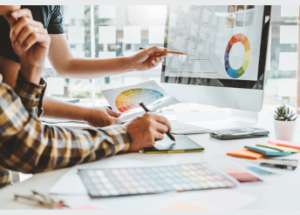Graphic design is a creative practice that utilises visual mediums such as posters, books, emails and computer prints to convey an idea or message.
 Designing is a complex skill set requiring creativity, innovation and lateral thinking to realise visions. Additionally, this job often requires close collaboration with clients and other specialists to comprehend the goals they have for their work.
Designing is a complex skill set requiring creativity, innovation and lateral thinking to realise visions. Additionally, this job often requires close collaboration with clients and other specialists to comprehend the goals they have for their work.
It’s all about visuals.
Graphic design is the art of conveying a message through visual mediums. It combines creativity and technology to produce captivating visuals that communicate a concept, idea or emotion to its target audience. Examples of graphic design include posters, business logos, magazines and advertisements.
Graphic design is heavily dependent on colour and shape. The right shades can draw attention, convey an idea or emote a feeling – especially blues and greens, which tend to capture imaginations best.
Another element of graphic design Adelaide involves texture. It can range from two-dimensional surfaces like fur or gravel to more abstract elements such as patterns and photography. With the appropriate textures, designers can express their brand or idea more effectively.
Other essential elements of visual design that must be considered are alignment, balance and contrast. Alignment helps keep your design organised, while balance ensures all elements have equal weight so your artwork doesn’t appear disjointed. The contrast created when using different colours in your design can be truly amazing; an excellent example is when different colour schemes come together to form a truly memorable piece of artwork.
It’s all about words.
Words are the essential building blocks of graphic design Adelaide. They communicate information in print, on film or package labels, and signs. Words help people decipher complicated systems, announce sales, entertain or persuade, and demonstrate a process. But designers don’t just rely on words – they also employ visual forms like typography and hand lettering for added impact.
Typography is the art of arranging letters in an eye-catching and legible way. It’s a skill that all designers should possess; they need to know how to effectively utilise different typefaces, sizes and styles when conveying their message to their audience.
Composition is key in the successful design, comprising balance, proximity, alignment and repetition. To ensure the most impactful elements are placed at the forefront of a piece’s composition, they must remain at their centre.
Negative space, the white area around design elements, is another essential design element that enhances readability and helps viewers focus on the main points.
The composition can also take shape in circles, squares, rectangles and other geometric forms. The colours, style, background and texture of these shapes influence how viewers perceive them; for instance, a circle may symbolise unity, while a square could signify structure. The shape is integral to good design, so any designer must learn this skill through practice and observation.
It’s all about balance.
Balance in graphic design is a fundamental concept designer must master to produce compelling compositions. Without proper balance, an image may appear disorganised, disoriented and distant to the eye.
Design can be balanced using several elements such as colour, line, texture and position. It plays an integral role in logo design, infographics and many other forms of branding.
The visual weight of different elements in a composition determines their appearance, and balance allows you to manipulate that visual weight for maximum impact. For instance, if one side of the design has lighter colours than the other, lines and edges can be used to add visual interest to that side while maintaining balance across all of it.
Symmetrical balance is the most popular type of aesthetic balance used in graphics. But it can also be achieved through subtle adjustments to design elements; changing one element’s colour could drastically shift the balance and create a focal point.
Symmetrical balance is a type of visual harmony that exudes gracefulness and simplicity in design. While it’s easy on the eyes, symmetrical compositions may feel dull without strong focal points to capture viewers’ attention.
On the other hand, asymmetrical balance offers a more visually appealing form of balance that’s more dynamic and captivating. While this type of arrangement can create interest, it could also appear messy or amateurish if your designer isn’t careful.





